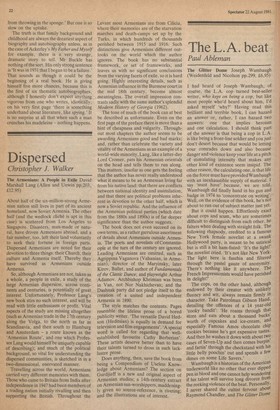Dispersed
Christopher J. Walker
The Armenians: A People in Exile David Marshall Lang (Allen and Unwin pp.203, 12.95) About half of the six-million-strong Armenian nation still lives in part of its ancient homeland, now Soviet Armenia. The other half (and the wedlock cliche is apt in this case) is scattered from Los Angeles to Singapore. Disasters, man-made or natural, have driven Armenians abroad, and a fair number, too, left their land voluntarily to seek their fortune in foreign parts. Dispersed Armenians are noted for their devotion to three things: their Church, their culture and Armenia itself. Thereby they have survived as Armenians outside Armenia.
So, although Armenians are not, taken as a whole, a people in exile, a study of the large Armenian dispersion, across continents and centuries, is potentially of great interest. Unfortunately, Professor Lang's new book stirs no such interest, and will be read with little enthusiasm or profit. Vital aspects of the study are missing altogether (such as Armenian trade in the 17th century along the Volga, to the north as far as Scandinavia, and then south to Hamburg and Amsterdam — a route known as the 'Armenian Route', and one which Professor Lang would himself be uniquely capable of describing); and much of the political background, so vital for understanding the dispersed communities, is sketched in in a two-dimensional, enervated manner.
Travelling across the world, Armenians carried very different memories with them. Those who came to Britain from India after independence in 1947 had been members of a trading nation initially rivalling and then supporting the British. Throughout the Levant most Armenians are from Cilicia, where their memories are of the starvation marches and death-camps set up by the Turks, in which hundreds of thousands perished between 1915 and 1916. Such distinctions give Armenians different outlooks on the world which the author ignores. The book has no substantial framework, or set of frameworks, and leaves us with no significant conclusions from the varying facets of exile, so it is hard going. Highly interesting details, such as Armenian influence in the Burmese court in the mid 18th century, become almost meaningless. The overall impression contrasts sadly with the same author's splendid Modern History of Georgia (1962).
The tone of much of the book can at best be described as unfortunate. Even on the first page of the preface there is more than a hint of cheapness and vulgarity. Throughout most chapters the author seems to be awarding Armenians good and bad marks; and, rather than celebrate the variety and vitality of the Armenians as an example of a world-wide minority, Lang, like a latter-day Lord Cromer, pats his Armenian orientals on the head and tells them to run along. This matters, insofar as one gets the feeling that the author has never really understood what it means to be an Armenian living far from his native land: that there are conflicts between national identity and assimilation, and that there are political problems inherent in devotion to the other half, which is now a Soviet republic. And the influence of the Armenian political parties (which date from the 1880s and 1890s) is of far deeper significance than the author suggests.
The book does not even succeed on its own terms, as a rather garrulous assortment of details about Armenians outside Armenia. The poets and novelists of Constantinople at the turn of the century are ignored. Leading Armenians are omitted, such as Agrippina Vaganova (Vahanian, in Armenian), director of the Maryinsky, later Kirov, Ballet, and author of Fundamentals of the Classic Dance; and playwright Arthur Adamov. Archbishop Khrimian was born in Van, not Nor Nakhichevan; and the Dashnak party did not pledge itself to the creation of a united and independent Armenia in 1890.
The style matches the contents. Pages resemble the lifeless prose of a bored publicity writer. 'The versatile David Hedson (Heditsian) is equally in demand for television and film engagements'. 'A special word is called for regarding that wellestablished favourite Cathy Berberian'. These artists deserve better than to have their talents turned to dross in such lacklustre prose.
Does anything, then, save the book from being a Compendium of Useless Knowledge about Armenians? The section on Gurdjieff is a new and original aspect of Armenian. studies; a 14th-century extract on Armenian sun-worshippers, maddeningly givenno source-reference, is riveting; and the illustrations are of interest.


































 Previous page
Previous page